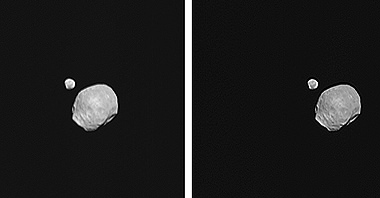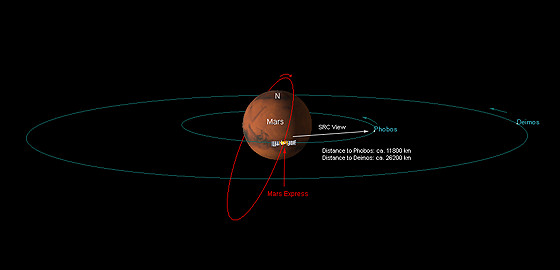ESA’s Mars Express orbiter took images last month of Mars two moons, Phobos and Deimos. This is the first time the moons have been imaged together in high resolution, but as Emily Lakdawalla points out on Planetary Blog, not the first time the two have been imaged together: the Spirit rover did it back in 2005! But these new image definitely provide a ‘wow’ factor, as well as helping to validate and refine existing orbit models of the two moons.

“It doesn’t happen very often that both Martian moons are right in front of the camera, directly one behind the other,” said Harald Hoffmann from the German Aerospace Center (DLR).
“During the now more than six-year long project, we have had several opportunities to photograph the two moons together,” said Klaus-Dieter Matz, who worked with Hoffmann to plan the acquisition of these images. “The geometry of the constellation during Orbit 7492 on 5 November 2009 was especially favorable, so this time we wanted to try taking a sequence of photographs – and this first attempt has delivered the expected result!”

Phobos, the larger of the two moons, orbits closer to the Red Planet, circling it every 7 hours and 39 minutes. It travels faster relative to Mars than the Moon relative to Earth. It was 11,800 km from Mars Express when the images were taken. Deimos was 26,200 km away.
The images were acquired with the Super Resolution Channel (SRC) of the High Resolution Stereo Camera (HRSC). The camera took 130 images of the moons on 5 November at 9:14 CET over period of 1.5 minutes at intervals of 1s, speeding up to 0.5-s intervals toward the end. The image resolution is 110 m/pixel for Phobos and 240 m/pixel for Deimos — since Deimos was more than twice as far from the camera.


I’m just thankful it wasn’t cloudy the day they took the pictures,
Very beautiful catch. Why don’t you ever see stars in the background of imaged objects such as planets and moons?
It’s because the planets and moons are so much brighter than the background stars. Only a short exposure is required to get a usable image of sunlit planets, but to get a picture of the stars the cameras would have to take a much longer exposure, which would result in over exposed images of the foreground planets and moons.
Because the camera sensor does not have the dynamic range to show the brighest and the dimmest objects in one single frame.
Either you expose for the moon correctly and underexpose for the stars, or you expose the stars correctly and overexpose the moon.
But who knows that HDR will be used in future missions too which uses 3 exposure combined to one single image.
It is exactly the same reason when you are outdoors and the sky is full of stars and I shine a bright light in your eyes, you also will not see stars next to the bright light..
Lakdawalla discuss the star field and gives links to photos including them:
“Spirit’s camera stood still as this animation was being captured; the star field was also drifting through the field of view, with the same sense of motion as Deimos, only faster. (A stacked version of this image sequence is available here, in which you can see how the background star field (including the bright star Aldebaran) was moving. I chose not to stretch the contrast in the images so you could see Aldebaran, because in doing so I would have saturated Phobos, making it harder for you to see how Spirit resolved its shape.) (Thanks to Dan for the tip to that image sequence.) [TL: Link removed by me; follow the post.]”
Oops. Also: Bold by me.
There’s a funny ‘drop’ illusion connecting them, esp in the last contact frame. Imaging or processing artefact?
Reminds of the Venus transit ‘black drop’.
A link to this frame, extracted and enlarged / interpolated:
http://files.myfrogbag.com/qe1mq0/phobosdeimos%20drop%20×2.png
*hopes link works*